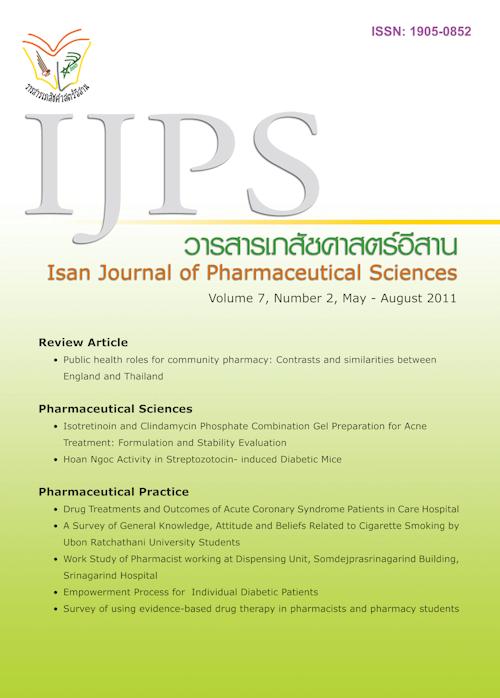Drug Treatments and Outcomes of Acute Coronary Syndrome Patients in Secondary-Care Hospital
Main Article Content
Abstract
Introduction: This study aimed to determine the prescribing rates for recommended drugs in early management, at discharge, and during ninety days of follow up in patients with acute coronary syndrome (ACS) in a secondary-care hospital. The survival rates and their risk factors were also investigated. Methods: This study was a retrospective medical chart review of ACS patients who were admitted in the hospital during the fscal year of 2008. Results: Two hundred and three patients were studied and classifed to be ST elevation myocardial infarction (STEMI) 27%, non-ST elevation myocardial infarction (NSTEMI) 41% and unstable angina (UA) 32%. In early management, 26% of STEMI patients received streptokinase while 56% and 35% of NSTEMI and UA patients received enoxaparin. Door-to-needle time of streptokinase was 13.87 ± 6.24 minutes. About 12% and 1% of patients were referred to tertiary-care hospitals for receiving coronary angiography (CAG) and percutaneous coronary intervention (PCI) respectively. The prescription rates of secondary prevention drugs at discharge and during ninety days of follow up were higher than 80% and 40% for anti-platelet drugs and statins respectively. However the prescribing rates of beta-blockers and angiotensin converting enzyme inhibitors (ACEIs) or angiotensin receptor blockers (ARBs) were lower than 40%. The prescription rates of secondary prevention drugs were highest in STEMI patients. The 1-year survival rates of STEMI, NSTEMI and UA were 73%, 71% and 67%, respectively. The independent risk factor was serum creatinine level of equal to or greater than 1.5 mg/dL (HR=2.42, 95%CI 1.26-4.65). Conclusion: This study revealed the useful information about treatments in acute coronary syndrome patients, and these will lead to the improvement in the quality of care in these patients.
Article Details
In the case that some parts are used by others The author must Confirm that obtaining permission to use some of the original authors. And must attach evidence That the permission has been included
References
Acute Coronary Syndrome Guidelines Working Group. Guidelines for the management of acute coronary syndromes 2006. MJA 2006; 184(8 Suppl): S1-S32.
Antman E, Hand M, Armstrong P, Bates E, Green L, Halasyamani L, et al. FocusedSupdate of theSACC/AHAT2004 guidelines for the management of patients with ST-Elevation myocardial infarction. Circulation 2004; 117, 296-329.
Ariyapim N, Suksomboon N, Wongvipaporn C, Chaikledkaew U. The rationale to guideline of treatment for secondary prevention in patients with acute coronary syndromes. Thai Journal of Hospital Pharmacy 2007; 17(Suppl): S68-S76.
Bradley EH, Herrin J, Elbel B, et al. Hospital quality for acute myocardial infarction: correlation among process measures and relationship with short-term mortality. JAMA. 2006; 296: 72-78.
Chaowalit N, Yipintsoi T, Tresukosol D, Kanjanavanit R, Kiatchoosakun S. Prognostic value of selected presenting features of acute coronary syndrome in predicting in-hospital adverse events: Insight from the Thai acute coronary syndrome registry. Internal medicine 2009; 48: 639-646.
Christine A, Richard H, Jack V, Pilote L. Administrative data feedback for effective cardiac treatment: AFFECT, a cluster randomized trial. JAMA 2005; 294(3): 309-317.
Christopher B, Steg P, Peterson E, Sendon J, Werf F, Rogers E, et al. Medication performance measures and mortality following acute coronary syndromes. Am J Med 2005; 118(8): 858-65.
Eimsophon S, Chotinaiwattarakul C. Association of in-hospital mortality after acute coronary syndrome with cardiogenic shock and patient characteristics, treatment strategies. Thai heart journal 2006; 19 (1): 25-30.
Ganova-Iolovska M, Kalinov K, Geraedts M. Qualityof care of patients with acute myocardialinfarction in Bulgaria: a cross-sectional study. BMC Health Serv Res 2009; 9:15.
Granger CB, Goldberg RJ, Dabbous O, Pieper KS, Eagle KA, Cannon CP et al. Predictors of hospital mortality in the global registry of acute coronary events. Arch Intern Med2003; 163: 2345-2353.
Hasdai D, Behar S, Wallentin L, Danchin N, Gitt A, Boersma E, et al. A prospective survey of the characteristics, treatments and outcomes of patients with acute coronary syndromes in Europe and the Mediterranean basin. European Heart Journal 2002; 23: 1190–1201.
Honda T, Kanazawa H, Koga H, Miyao Y, and Fujimoto K. Heart rate on admission is an independentrisk factor for poor cardiac function and in-hospital death after acute myocardial infarction. J Cardiol 2010 Sep;56(2):197-203.
Jack V, Khalid L, Donovan LR, Dennis T. Indicators of quality of care for patients with acute myocardial infarction. CMAJ 2008; 179(9): 909-915.
Mahaffey KW, Yang Q, Pieper KS, Antman EM, White HD, Goodman SG et al. Prediction of one-year survival in high-risk patients with acute coronary syndromes: results from the SYNERGY trial. J Gen Intern Med 2008; 23(3): 310–316.
Mandelzweig L, Battler A, Boyko V, Bueno H, Danchin N, Filippatos G, et al. The second Euro Heart Survey on acute coronary syndromes: characteristics, treatment, and outcome of patients with ACS in Europe and the Mediterranean Basin in 2004. European Heart Journal 2006; 27: 2285–2293.
Ministry of Public Health. Health statistics 2002. [Online]. [cited 2010 Mar 17]. Available from http://www.moph.go.th/stat1.php
Research Office, the Heart Association of Thailand Under the Royal Patronage of H.M. The King. Thai Acute Coronary Syndrome Registry. Bangkok: 2006.
Srimahachota S, Kovitoonkit V, Intarakhamthornchai T, editors. Clinical practice in in-patients. 3rd ed. Chulalongkorn University Print; 2005.
The Heart Association of Thailand Under the Royal Patronage of H.M. The King. Clinical practice guidelines in ischemic heart disease patients. [Online]. [cited 2011 Jun 1]. Available from http://www.thaiheart.org/images/column_1291454908/CADGuideline.pdf
UCLA: Academic Technology Services, Statistical Consulting Group. Statistical Computing Seminars, Survival Analysis with Stata, Exploring the data: Univariate Analyses, Model Building. [Online]. November 24, 2007 [cited 2010 Sep 17]. Available from http://www.ats.ucla.edu/stat/stata/seminars/stata_survival/default.htm#exploring
Viskin S, Barron HV. Beta-blockers prevent cardiac death following a myocardial infarction: so why are so many infarct survivors discharged without beta- blockers? Am J Cardiol 1996; 78(7): 821-822


